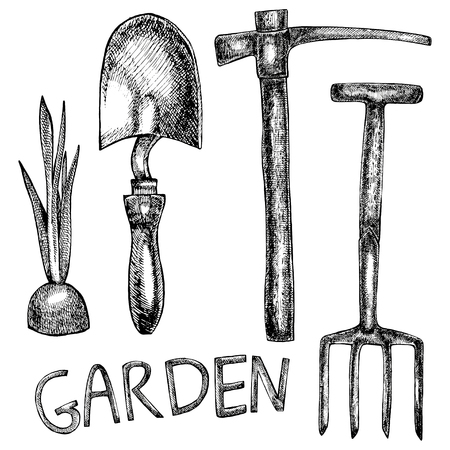Origins and Historical Roots of the British Hoe
Imagine stepping into a time long before trowels and garden forks filled our sheds—where the humble hoe first found its place in British soil. The story of the British hoe begins with simple hand-forged blades, crafted by blacksmiths who understood the needs of small village plots. Early hoes were essential tools for tilling the earth, breaking up heavy clay, and preparing beds for vegetables that would nourish generations. As you might share tales of discovery with a curious child in your garden, so too did early gardeners experiment with shapes and materials to suit the changing British landscape. With the rise of cottage gardens during the 17th and 18th centuries, the hoe became an indispensable companion to families growing their own food. Its evolution mirrored Britain’s rural life—adapting from crude wooden handles and iron heads to more refined forms, perfect for weaving between rows of beans or uprooting stubborn weeds. Each adaptation reflected not only advances in toolmaking but also the close-knit relationship between people, plants, and place—a partnership as nurturing as parent and child working side by side beneath the English sky.
2. Distinctive Styles across the UK
The humble hoe, while simple in concept, has blossomed into a variety of distinctive styles across Britain—each shaped by local soils, planting traditions, and the gardening culture unique to its region. Just as families might adapt their routines to suit different children’s needs, so too have British gardeners adapted their tools for their particular patch of earth. In the heavy clays of the Midlands, sturdy chopping hoes reign supreme; meanwhile, in the peaty soils of Scotland, lighter draw hoes are favoured for their nimbleness. Let’s dig deeper and explore how these regional differences have inspired such a delightful diversity in British hoe design.
| Region | Hoe Style | Key Features | Typical Use |
|---|---|---|---|
| Midlands | Chopping Hoe | Heavier blade, shorter handle | Breaking tough clay soil and deep weeding |
| Scotland | Draw Hoe | Lighter weight, angled blade | Weeding among root crops in loose peat |
| Southeast England | Dutch Hoe | Flat, sharp blade; long handle | Slicing weeds just below the surface in sandy soils |
| Cornwall & Devon | Turfing Hoe | Narrow blade; robust build | Cutting turf and clearing stony ground for planting potatoes |
This regional tapestry is more than just history—it’s a living example of how gardeners, like parents guiding their little ones, observe and respond to nature’s cues. The tradition of passing down favourite hoe designs within families is still alive today, nurturing not only plants but also a sense of belonging and continuity. Each hoe tells a story rooted in its landscape—a quiet reminder that sometimes the best solutions are those closest to home.

3. Traditional and Modern Day Uses
In the heart of British gardening, the hoe has always played a starring role—whether nestled amongst the rows of an allotment or in the well-tended borders of a family garden. Traditionally, the hoe was as much a symbol of community as it was a tool, passed from hand to hand, generation to generation. Children would watch their parents or grandparents deftly using hoes to weed between rows of runner beans or to break up stubborn clods after a rainstorm, learning not only the skills but also the quiet rhythm of working with the land.
Today, while technology has introduced new gadgets, many British gardeners—young and old—still reach for their trusty hoe when faced with unruly weeds or compacted soil. It’s a tool that encourages everyone to get involved: little ones might start by helping to mark out vegetable beds, while older hands tackle tougher jobs like cultivating heavy clay or prepping ground for spuds. On classic allotments dotted across villages and towns, you’ll still spot neighbours exchanging tips on how best to use a Dutch hoe for slicing off weed heads or a draw hoe for earthing up potatoes. These simple rituals connect past and present, making gardening both a shared family activity and a cherished tradition.
Whether preparing seedbeds for spring sowings or keeping beds tidy throughout the summer, hoes remain indispensable in British gardens. Their versatility bridges generations—reminding us that sometimes, the best way to nurture both plants and relationships is by getting our hands dirty together.
4. Choosing the Right Hoe for Your Patch
Finding the ideal hoe for your British garden is a bit like choosing the right shoes for a family walk through the countryside – it should fit both your needs and your environment. Whether you’re guiding little hands as they help with weeding or tending to a patch of wildflowers, selecting the perfect hoe can make all the difference in nurturing both your plants and your family’s love of gardening.
Consider Your Garden Size and Soil Type
British gardens come in all shapes and sizes, from narrow terrace plots to sprawling cottage borders. Here’s a simple guide to matching hoes with garden types:
| Garden Size | Recommended Hoe Style | Benefits |
|---|---|---|
| Small urban plots/allotments | Swan-neck or Draw hoe | Easy manoeuvrability, precise weeding between rows |
| Cottage gardens/large beds | Dutch hoe (push hoe) | Quickly covers larger areas, ideal for surface weeds |
| Heavy clay soil | Chopping/grubbing hoe | Breaks up tough ground, suitable for robust jobs |
Selecting for Common British Plants
Take note of what you’ll be growing. If your patch is filled with classic blooms like roses, foxgloves, and lavender, or staples such as potatoes and carrots, choose a hoe that allows gentle cultivation around roots without causing damage. For delicate seedlings, a narrow-bladed onion hoe offers control; for more established plants, a wider head helps keep pathways clear.
Family-Friendly Tips for Beginners
- Lightweight tools: Choose aluminium or ash-handled hoes that smaller hands can manage.
- Sized to fit: Adjustable handles allow everyone—from children to grandparents—to get involved comfortably.
- Safety first: Rounded edges on hoe blades reduce risk if little ones are eager helpers.
- Get hands-on: Let children pick their own small hand hoes – it encourages responsibility and pride in their patch.
A Plant-Inspired Thought:
Much like choosing the right pot for each seedling, picking the proper hoe helps every family member grow in confidence and skill. With the right tool in hand, tending to your British garden becomes a shared adventure—rooted in tradition yet blossoming with new memories each season.
5. Maintenance and Care in the British Climate
Looking after your hoe isn’t just about prolonging its life—it’s a cherished routine that keeps us connected to generations of gardeners before us. In the ever-changing British weather, from misty mornings to summer downpours, proper care is essential. Let’s roll up our sleeves and pass along some hands-on wisdom for keeping your trusty hoe ready for action, whatever the forecast.
Cleaning After Each Use
After every gardening session, give your hoe a good wipe-down to remove soil and moisture. Use a stiff brush or an old rag—children love helping with this bit! For stubborn dirt, rinse briefly with water, but always dry thoroughly to prevent rust, especially on those classic steel blades so beloved in British sheds.
Sharpening for Efficiency
A sharp hoe makes light work of weeding and cultivating. Every few weeks, use a mill file or sharpening stone to maintain a keen edge, following the angle of the blade. Invite children or grandchildren to watch and learn; it’s a satisfying task that teaches respect for tools and safety awareness.
Storing for All Seasons
British weather is famously unpredictable—so store your hoe somewhere dry and sheltered, like a garden shed or garage. Hang it up if possible, handle-side down, to avoid warping the wood. For extra protection, rub a little linseed oil into wooden handles each season, keeping them smooth and splinter-free for small hands and big alike.
By sharing these simple routines, we ensure our hoes—and our love of gardening—stand the test of time and weather. It’s not just tool care; it’s family tradition in every sweep and stroke.
6. Sustainability and Passing Down Tradition
In British gardens, the humble hoe is more than just a tool—it’s a thread connecting generations. Embracing sustainability means not only choosing eco-friendly materials and methods for hoe care, but also nurturing the stories and wisdom that have been passed down through families. When you pick up your hoe, consider how its handle might have been shaped by your grandparent’s hands, or how its blade has weathered many seasons of English rain and sun. Encourage children to join you in the garden, sharing tales of how each family member has cared for their tools—whether it’s applying linseed oil to wooden handles or storing hoes carefully in a dry shed. These rituals foster a sense of stewardship rooted deeply in the British ethos: we are caretakers of our land and its traditions.
Eco-Friendly Choices in Hoe Care
Opt for locally-sourced, sustainably-harvested materials when replacing parts or buying new hoes. Use natural oils and waxes to protect wooden handles instead of chemical-laden alternatives. Recycle or repurpose old metal blades as garden markers or creative sculptures. By making thoughtful choices, you ensure that both your tools and your environment thrive for future generations.
Sharing Wisdom Across Generations
Bring family together for annual ‘tool care days’—a cherished opportunity to pass on practical skills like sharpening blades and checking for loose fittings. Share anecdotes about past gardening triumphs (and the occasional blunder!), reinforcing that learning and laughter go hand-in-hand in the garden. This shared experience instils respect for craftsmanship and an appreciation for the humble hoe’s evolving role in British horticulture.
Cultivating a Lasting Legacy
By intertwining sustainable practices with family traditions, you create a living legacy that honours both nature and heritage. The British hoe, with its rich history of styles and uses, becomes not just an implement but a symbol—a reminder that every weed cleared and bed prepared is part of a story still unfolding beneath our feet.


